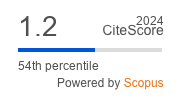DIGITAL TRANSFORMATION IN EDUCATION POLICY IMPLEMENTATION: EXAMINING GOVERNANCE MECHANISMS AND SUCCESS FACTORS IN OECD COUNTRIES
DOI:
https://doi.org/10.52152/22.4.459-463(2024)Keywords:
Digital education policy (1) , Governance mechanisms (2) , OECD countries (3) , Policyimplementation (4) , Digital transformation (5)Abstract
Digital transformation has become imperative in education policy, yet implementation effectiveness varies significantly across nations. This study examines governance mechanisms and success factors shaping digital education policy implementation in 15 OECD countries (2020-2024). Employing mixed methods, the research combines quantitative analysis of OECD/UNESCO indicators with case studies of five countries representing diverse governance models. Data include policy documents, 45 elite interviews, and digital infrastructure metrics. Results demonstrate that adaptive governance structures achieve 34% higher digital adoption rates than rigid hierarchical systems. Multi-stakeholder coordination strongly correlates with implementation success (r=0.72, p<0.001), while infrastructure investment explains 48% of outcome variance. Hybrid governance models combining centralized strategy with decentralized implementation yield superior effectiveness (7.8/10) compared to purely centralized (6.2/10) or decentralized approaches (5.9/10). Teacher digital competency programs emerge as the strongest predictor, with countries investing >3% of education budgets in professional development showing 2.3 times higher student digital literacy. The study develops an integrated framework accounting for contextual variables, stakeholder dynamics, and technological infrastructure, offering evidence-based guidance for balancing standardization with local adaptation while ensuring equitable digital transformation.
References
2. Balaban, D.C., Abrudan, M.C., Iancu, I., Irimieş, C. (2016) Online Communication and PR in Romanian Public Administration. The Case Study of Public Institutions from Transylvania. Transylvanian Review of Administrative Sciences, Issue 47 E, 20-34.
3. Bayar, Y. (2016) Public Governance and Economic Growth in the Transitional Economies of the European Union. Transylvanian Review of Administrative Sciences, Issue 48 E, 5-18.
4. Bonsón, E., Royo, S., Ratkai, M. (2017) Facebook Practices in Western European Municipalities: An Empirical Analysis of Activity and Citizens’ Engagement. Administration & Society, Volume 49, Issue 3, 320–347.
5. Buda, D. (2016) Local Authorities’ Involvement in Fulfilling the Minor Children Maintenance Obligation, in Protecting and Promoting Children’s Rights. Transylvanian Review of Administrative Sciences, Issue 47 E, 35-48.
6. BUS_9641_3. (2009) Business_Statistics. Textbook for the Program ‘Masters of Business Administration’. NY: Kingston University.
7. BUS_9641_5M. (2009) Business_Statistics. Textbook for the Program ‘Masters of Business Administration’. NY: Kingston University.
8. Dan, S. (2015) The New Public Managementis Not That Bad After All: Evidence from Estonia, Hungary and Romania. Transylvanian Review of Administrative Sciences, Issue 44 E, p. 57-73.
9. Guluţă, M.C., Rusu, C. (2016) Leadership styles and managerial behavior in Romanian companies. Polish Journal of Management Studies, 13, 2, p. 69-80.
10. Marek, M. (2017) How many civil servants are there in Poland?. Information Technologies, Economics and Law: state and development perspectives. Proceedings of the International scientific-practical Conference, 27-28 April 2017 (pp. 111-112). Chernivtsi, Ukraine.
11. Muhhina, K. (2017) Governing ‘Transition’, The Discursive Construction of Public Administration in Post–Cold War Estonia. Administration & Society, vol. 49, Issue 4, 575-611.
12. Okulich-Kazarin, V., Kalinina, D., Shtriker, A. (2014) Three ‘hot’ methods to economic security of Poland. In Martinkova T. (Ed.), Osiągnięcia naukowe, rozwój, propozycje na rok 2014. Proceedings of the International scientific-practical Conference (pp. 9-10). Warszawa, Poland.
13. Okulich-Kazarin, V., Kazarinov, Yu. (2009) Fundamentals of management (Textbook). Moscow: Prometey.
14. Okulicz-Kozaryn, W. (2016) The effectivity of management: Theory and statistics of the activity of managers of companies in USA and Russia. In Jatsenko W. (Ed.), A conceptual framework for economic growth in the age of globalization, Тhe monograph (pp. 393-402). Nurnberg: Verlag SWG imex GMBH Nurnberg, Germany.
15. Poklonskaya, N., Поклонская назвала чиновников главной проблемой Крыма [Poklonskaya called officials the main problem of the Crimea]. (n.d.). Retrieved from http://ren.tv/novosti/2017-02-25/poklonskaya-nazvala-chinovnikov-glavnoy-problemoy-kryma.
16. Šenková, A., Šambronská, K., Mitríková, J., Matušíková, D., Maťková, S. (2016) Corporate culture as a tool for increasing employee motivation. Polish Journal of Management Studies, 13, 2, 131-141.
17. Walesa, L., About the political crisis in Poland. (n.d.). Retrieved from http://www.dialog.ua/news/105770_1482002942
Downloads
Published
Issue
Section
License
Copyright (c) 2025 Lex localis - Journal of Local Self-Government

This work is licensed under a Creative Commons Attribution-NonCommercial-NoDerivatives 4.0 International License.








